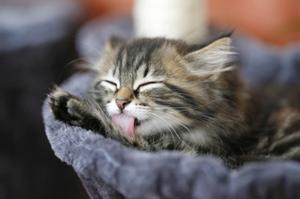

Contrary to popular belief, cat hair is not the cause of allergic reactions.
Allergens produced primarily in the cat’s salivary and sebaceous (skin) glands are responsible for triggering a reaction in allergic individuals.1-3
These allergens are transferred to the hair and skin when a cat grooms and spread into the environment on shed hair and dander. Although the cat’s hair can carry the allergens, the hair itself is not the originating cause of allergies to cats.
The facts
When most people have an allergic reaction to cats, they are usually responding to one allergen in particular, known as Fel d 1.1,4
- Fel d 1 is produced in the salivary, sebaceous (skin) and anal glands of cats.1,5,6
- Fel d 1 is spread throughout a cat’s hair and skin during grooming, and then dispersed on dander (dried flakes of skin) and shed hair around the home.1,2,5,7,8
Find out more
- Bonnet, B., Messaoudi, K., Jacomet, F., Michaud, E. Fauquert, J.L., Caillaud, D., & Evrard, B. (2018). An update on molecular cat allergens: Fel d 1 and what else? Chapter 1: Fel d 1, the major cat allergen. Allergy, Asthma and Clinical Immunology, 14, 14. doi: 10.1186/s13223-018-0239-8
- Salo, P.M., Cohn, R.D., & Zeldin, D.C. (2018). Bedroom allergen exposure beyond house dust mites. Current Allergy and Asthma Reports, 18, 52. doi: 10.1007/s11882-018-0805-7
- Zahradnik, E. & Raulf, M. (2017). Respiratory allergens from furred mammals: environmental and occupational exposure. Veterinary Sciences 4, 38. doi: 10.3390/vetsci4030038
- van Ree, R., van Leeuwen, W., Bulder, I., Bond, J. & Aalberse, R. (1999). Purified natural and recombinant Fel d 1 and cat albumin in in vitro diagnostics for cat allergy. Journal of Allergy and Clinical Immunology, 104, 1223-1230.
- Luczynska, C., Li, Y., Chapman, M., & Platts-Mills, T. (1990). Airborne concentrations and particle size distribution of allergen derived from domestic cats (Felis domesticus). Measurements using cascade impactor, liquid impinger, and a two-site monoclonal antibody assay for Fel d 1. American Review Respiratory Diseases, 141, 361-367.
- Kelly, S.M., Karsh, J., Marcelo, J., Boeckh, D., Stepner, N., Litt, D.,...Yang, W.H. (2018). Fel d 1 and Fel d4 levels in cat fur, saliva and urine. Journal of Allergy and Clinical Immunology. doi: 10.1016/j.jaci.2018.07.033
- Bartholome, K., Kissler, W., Baer, H., Kopietz Schulte, E., & Wahn, U. (1985). Where does cat allergen 1 come from? Journal of Allergy and Clinical Immunology, 76, 503-506.
- Dabrowski, A., Van der Brempt, X., Soler, M., Seguret, N., Lucciani, P., Charpin, D., & Vervloet, D. (1990). Cat skin as an important source of Fel d 1 allergen. Journal of Allergy and Clinical Immunology, 86, 462-465.